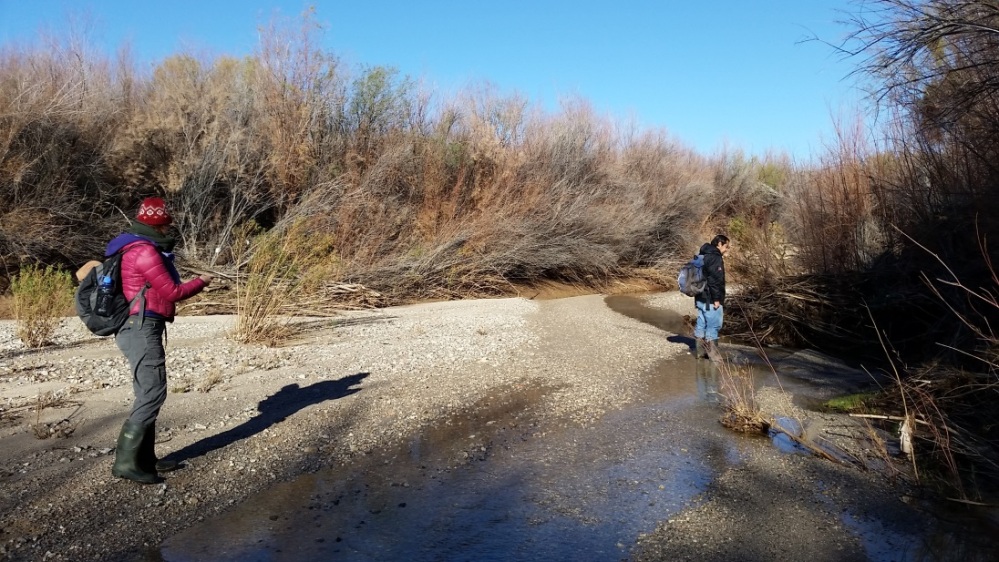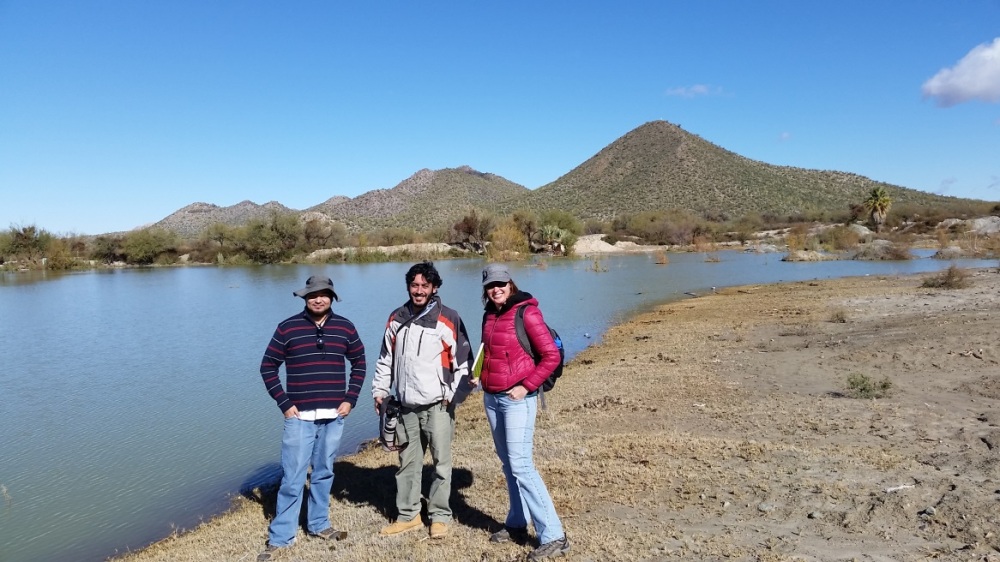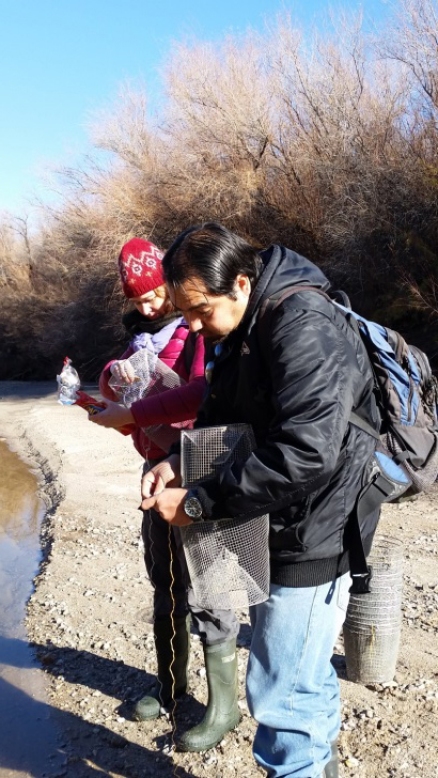Arizona-Sonora Desert Museum, along with Organ Pipe National Monument and Pinacate Biosphere Reserve, have teamed up on a unique conservation and education project (funded by a grant from the National Park Service). The three organizations are uniting to help ensure species survival of Sonoyta pupfish (formally known as Quitobaquito pupfish) and the Sonoyta mud turtle.
Commonly referred to as the ‘Land of Black Volcanoes and White Sand’ the Pinacate and Gran Desierto De Alta Biosphere Reserve is truly the heart of the Sonoran Desert. The Park shares the international boundary with Organ Pipe Cactus National Monument and Cabeza Prieta National Wildlife Refuge to the north and borders the Upper Gulf of California and Colorado River Delta Biosphere Reserve. We hiked to the top of a 300 foot sand dune and enjoyd a view of the Sea of Cortez, gaining a deeper appreciation of this vast and protected region consisting of more than 2,700 square miles. Exploring the Schuk Toak Visitor Center and interacting with staff, we were reminded that the region provides critical habitat and wildlife corridors to a wide array of species, such as, the endangered pronghorn (the fastest land animal of the Americas), lesser long-nosed bat (pollinator of columnar cacti), flat tail horned lizard (enjoys a diet of ants), Monarch butterfly (adults travel over 2000 miles) and so much more. The Park also protects and interprets cultural and sacred sites of indigenous peoples.

Our journey to the Pinacate region was to begin understanding the complexities of caring for the critically endangered Sonoyta Pupfish and Sonoyta mud turtle and help share and exchange knowledge, disseminate information and raise public awareness. The first day ‘in-the-field’ we were rained out and could not conduct fish and turtle counts due to the high water flow of the Rio Sonoyta. Associate Director, Horacio Ortega explained that the river rarely flows beyond the northern perennial stretch and it happened to be flowing today. He asked if we wanted to walk over and see the river which we enthusiastically agreed. After a short walk, we discovered a dry drainage had come to life. Since our field day was ‘flooded out,’ we made plans to visit several sites where pupfish were being maintained with hopes of conducting a fish count in the Rio Sonoyta in a few days’ time.
During our visit, we quickly saw how the power of making a difference in your own backyard is something that Pinacate park biologists, high school students, Schuk Toak Vistor Center, and the Intercultural Center for the Study of Deserts and Oceans (CEDO) are all accomplishing in Sonora, Mexico. Two high schools have built small ponds on their campus that not only provide education for students about endangered species, but provide critical back-up populations that are helping to maintain assurance populations of the Sonoyta pufish. The Schuk Toak Vistior Center at the Reserve and CEDO are also providing fish refuge as well. These combined efforts are helping bring awareness of the biodiversity and conservation initiatives of the region.

Horacio Ortega and park biologists, Miguel Grageda and Roman Ramirez, shared the continuing challenges of maintaining refugium (fishkeeping) populations and the need to successfully propagate these critical species. They explained that they regularly visit each of these sites, conduct fish counts and inspect water quality, and access reproduction success. Thanks to the commitment of Colegio De Bachilleres Del Estado De Sonora (COBACH) high school in Sonoyta, additional longfin dace will be transferred to the Centro De Estudios Technologicos Del Mar (CETMAR) School in Puerto Pensaco (Rocky Point) to continue to increase their current fish population. Without this intervention, pupfish, and longfin dace would lie in a precarious balance of imminent extinction. Assurance populations are also being maintained in Arizona at Organ Pipe Cactus National Monument’s Visitor Center and at the Arizona-Sonora Desert Museum.

Unlike many species that are endangered, there is good news; habitat exists for wild populations of pupfish and mud turtles in the Rio Sonoyta. We visited the small stretch of perennial water flow of this vast river, located in the northern region of the Pinacate Reserve, to conduct pupfish, and mud turtle counts along with a bird survey. During our brief visit, numerous birds were recorded, a bobcat was seen crossing the river, and 283 pupfish and 15 mud turtles were counted. We learned that longfin dace (another endangered fish) have not been seen in the river since 2008, due to habitat change. Biologists shared with us that longfin dace require deeper water than the pupfish and can no longer be released due to low water levels.
We were surprised to find active mud turtles on a cold day, and learned that these animals only remain in the wild at Quitobaquito Oases in Organ Pipe Cactus National Monument in Arizona, the upper stretches of the Rio Sonoyta in Mexico, a section of the waste water runoff in the town of Sonoyta (which will be dried in the near future) and at the oases at Quitovac, a Tohono O’odham village located southeast of Sonoyta. Pupfish can be found in these areas as well.
Besides threats of decreased water flow in the Rio Sonoyta, there are concerns of invasive species. At the oases at Quitovac, threats include introduced exotic species, tilapia and mosquito fish, which compete for food of the pupfish. Tamarisk (an invasive and exotic plant) is another problem, due to it being able to quickly establish itself in the surrounding landscape, and along the water edge. Next month, we will return to the oases and remove tamarisk seedlings, organize a trash pick-up with elementary students and conduct fish counts.

It’s always a reminder when visiting aquatic habitats in the Sonoran Desert, that water is precious, should be respected, and is a vital resource to both wildlife and people. It is tied to almost every resource we rely on. 85% of wildlife species depend on surface water or an associated riparian habitat in some phase of their life cycle. The urgency is to act now -as habitat conversion and the introduction of game fish and other exotic species, take the place of native fish populations on both sides of the border.
Returning home and crossing the international boundary, the landscape and conservation goals remain the same. Collaborative efforts between the Desert Museum, National Parks, and the peoples of the region are vital. May we be so lucky to instill conservation stewardship to the next generation, make a difference in our communities and protect and conserve this place we call home, the Sonoran Desert.
Written by Marie Long, Associate Director of Conservation, Education, & Science














2 Comments Add yours